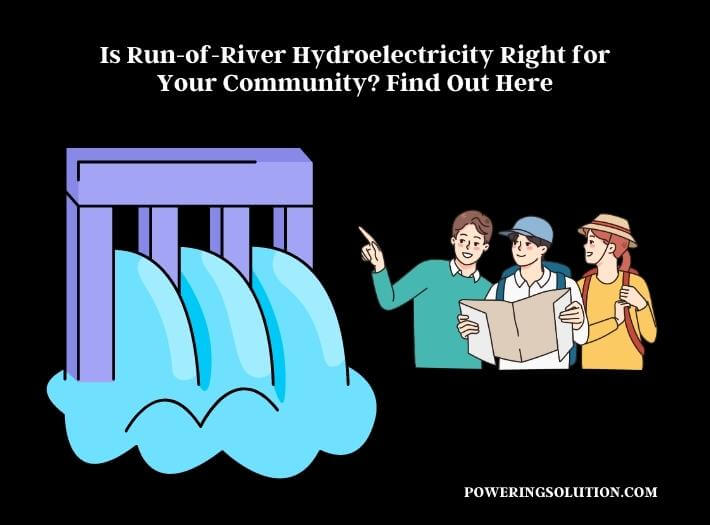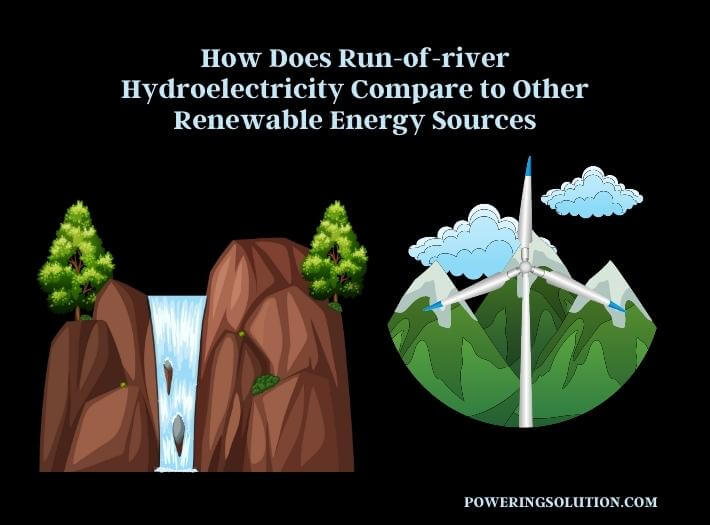As the world faces the urgent challenge of mitigating climate change, many communities are exploring ways to transition to renewable energy sources. One technology that has gained attention in recent years is run-of-river hydroelectricity, a type of hydropower that generates electricity from the natural flow of a river, without the need for a large dam or reservoir.

While run-of-river hydroelectricity has several advantages over other forms of hydropower, such as a smaller environmental footprint and faster deployment time, it also faces some challenges, such as dependence on water flow variability and potential impacts on river ecology and upstream uses.
It’s important to evaluate whether run-of-river hydroelectricity is the best option for a community based on various factors, including local water resources, economic and social benefits and costs, and regulatory frameworks.
What is Run-of-river Hydroelectricity?
Run-of-river hydroelectricity is a type of hydropower that generates electricity using the natural flow of a river, without the need for a large dam or reservoir. In this system, water from a river is diverted into a channel or pipeline, which leads to a turbine.
As the water flows through the turbine, it drives a generator that produces electricity. Once the water has passed through the turbine, it is returned to the river downstream. Unlike traditional hydropower plants that require the construction of large dams and reservoirs, run-of-river systems have a much smaller environmental footprint and can be installed more quickly.

Run-of-river hydroelectricity is dependent on the variability of water flow, and changes in the river’s water levels can affect the output of the power plant. The installation of run-of-river systems can have potential impacts on the ecology of the river and upstream water uses.
Advantages of Run-of-river Hydroelectricity
Compared to other forms of hydropower, such as large dams or pumped storage, run-of-river hydroelectricity has several advantages:
- It has a smaller environmental footprint, as it does not require the construction of a large dam or reservoir, which can cause habitat loss, sedimentation, and displacement of communities.
- It has a faster deployment time and lower capital costs, as the infrastructure is simpler and less extensive than for a large dam.
- It has a lower impact on downstream flow regimes, as it does not store water for later use or release, which can affect the natural flow and temperature of the river.
- It has a higher efficiency and capacity factor, as it can operate at a wide range of flow rates and respond quickly to changes in demand or weather conditions.
Challenges of Run-of-river Hydroelectricity
While run-of-river hydroelectricity has several advantages, it also faces some challenges that need to be considered before implementing this technology in a community. One of the biggest challenges is the dependence on water flow variability. As the power output of run-of-river systems is directly proportional to the flow of the river, changes in the water level can affect the amount of electricity generated. This means that during periods of low water flow, the power output of run-of-river systems can be significantly reduced, which can have implications for the reliability and stability of the electricity supply.
Another challenge is the potential impacts on river ecology and upstream water uses. The installation of run-of-river systems can alter the natural flow and temperature of the river, which can affect aquatic ecosystems and the habitats of various species. The diversion of water from the river for electricity generation can have impacts on other upstream water uses such as irrigation, fishing, and recreation. Therefore, it is essential to carefully assess the potential environmental impacts of run-of-river projects before implementing them.
The economic and social costs and benefits of run-of-river hydroelectricity must be considered. While run-of-river systems can provide a source of clean energy and create local job opportunities, they can also be expensive to build and maintain, and the costs may be passed on to consumers. Run-of-river projects may face opposition from local communities and stakeholders who are concerned about the potential environmental impacts.
Considerations for Implementing Run-of-river Hydroelectricity in Your Community
If your community is considering implementing run-of-river hydroelectricity, there are several important considerations to take into account. Here are a few:
Water availability and variability: As run-of-river systems rely on the natural flow of the river, it’s essential to evaluate the water availability and variability in your community. It’s important to assess the river’s flow patterns, seasonal changes, and any upstream water uses that may be impacted by the diversion of water for electricity generation.
Environmental impact assessment: Before implementing run-of-river hydroelectricity, it’s crucial to conduct a comprehensive environmental impact assessment to identify any potential impacts on river ecology and upstream water uses. This assessment should include a detailed analysis of the river’s hydrology, fish and wildlife habitats, water quality, and downstream water uses.
Economic and social feasibility: Run-of-river hydroelectricity projects can be expensive to build and maintain, and the costs may be passed on to consumers. Therefore, it’s essential to conduct a comprehensive cost-benefit analysis to assess the economic and social feasibility of the project. This analysis should include an evaluation of the project’s economic benefits, such as job creation and local economic development, as well as its potential costs, such as construction, maintenance, and operational expenses.
Regulatory framework: It’s essential to understand the regulatory framework governing run-of-river hydroelectricity in your community. This may include obtaining permits and approvals from regulatory agencies, complying with environmental regulations, and engaging with local stakeholders and communities.
Community engagement: Run-of-river hydroelectricity projects can face opposition from local communities and stakeholders who are concerned about the potential environmental impacts. Therefore, it’s crucial to engage with the community early in the planning process, address their concerns, and incorporate their feedback into the project design.
Is Run-of-river Hydroelectricity Right for Your Community?
To determine whether run-of-river hydroelectricity is the best option for your community, you need to consider several factors:
- The availability and variability of water flow in your local river, including seasonal and climate change effects.
- The potential impacts on the river’s ecology, hydrology, and downstream uses, such as fishing, irrigation, or recreation.
- The economic and social benefits and costs of the technology, including the capital and operating expenses, the revenue and savings from electricity sales or offsetting, and the potential job creation and community engagement opportunities.
- The regulatory and legal frameworks govern the development and operation of the technology, including environmental assessments, permits, and agreements with stakeholders.
How Does Run-of-river Hydroelectricity Compare to Other Renewable Energy Sources?
Run-of-river hydroelectricity has several advantages over other renewable energy sources, such as solar and wind power, in terms of its reliability and stability of power output. Unlike solar and wind power, which are intermittent and depend on weather conditions, run-of-river hydroelectricity can generate electricity continuously as long as there is sufficient water flow in the river. This makes it a more reliable and predictable source of energy, which can help stabilize the power grid and reduce the need for backup power sources.

Run-of-river hydroelectricity may not be suitable for all locations and depends on the natural flow of the river. In some regions, water flows may be highly variable, which can affect the power output of run-of-river systems. In such cases, a mix of renewable energy sources may be needed to provide a more reliable and diversified energy supply.
Run-of-river hydroelectricity is an important and valuable source of renewable energy that can complement other sources such as solar and wind power. Its advantages in terms of reliability and stability make it an attractive option for communities and countries looking to transition to clean energy sources while ensuring a stable and predictable power supply.
If you want to know do all solar panels produce DC power? Click here for details.
In a Nutshell
Run-of-river hydroelectricity can be a viable and sustainable source of renewable energy for communities that have access to a river with the sufficient flow. It has several advantages over other renewable energy sources, such as its reliability and stability of power output. Careful consideration of the potential impacts on river ecology and upstream water uses, as well as the economic and social costs and benefits, is crucial before implementing run-of-river projects.
When evaluating the feasibility of run-of-river hydroelectricity, it’s important to consider local conditions, such as water flow variability, available technology, and community preferences. A mix of renewable energy sources may be needed to provide a reliable and diversified energy supply that can meet the energy needs of the community.
Despite the challenges, run-of-river hydroelectricity has demonstrated its potential to provide clean, renewable energy and create local job opportunities while minimizing environmental impacts. With careful planning and management, run-of-river hydroelectricity can be a valuable and sustainable energy option for communities looking to transition to a more sustainable and resilient energy system.
